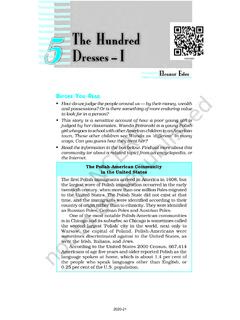Transcription of 1,000,000,000 – One Billion Years Ago
1 This Billion - year Walk begins on Lake Merritt near the corner of at the Rotary Nature Center Perkins Street and Bellevue Avenue 1,000,000,000 One Billion Years Ago Geology o Fordham Gneiss a metamorphic rock is forming and will underlie a portion of the future New York City. o The Earth s landmasses form one huge supercontinent, Rodinia. Supercontinent Rodinia Image by Zina Deretsky used courtesy of the National Science Foundation. Biology o There are no plants or animals. Among the eukaryotic single-celled organisms, some groups are becoming different.
2 Descendents of five of these groups will survive into the 21st Century and become the Protozoa, the Plants & Algae, the Slime Molds, the Animals, and the Fungi. Tree of Life for Eukaryotes Adapted from image released into the public domain by its author, Tim Vickers at the wikipedia project. Climate / Atmosphere o Cyanobacteria have been releasing oxygen into the oceans for over a Billion Years and have raised its concentration in the atmosphere from near zero to somewhat less than 2%; not enough oxygen for humans to survive for more than a few minutes.
3 In the 21st Century, oxygen concentration in the atmosphere will be 21%. o The Earth spins so fast that each day sunrise to sunrise i s 18 hours. 900,000,000 Nine hundred Million Years Ago Geology o Supercontinent Rodinia remains stable. Biology o Some eukaryotic organisms have become colonial; each cell is identical to the others. Increased oxygen levels in the atmosphere assist in supplying the higher energy requirements for these organisms. A choanoflagellate colony like the one pictured below will not only give rise to 21st Century choanoflagellates, but will also give rise to all multicellular true animals: sponges, fish, lizards, kangaroos, beetles, people, etc.
4 Choanoflagellate Colony Image released into the public domain by its author, Dhzanette at the English Wikipedia project. Climate / Atmosphere o Oxygen in the oceans is outgassing into the atmosphere at a greater rate but the atmospheric concentration is still less than 3 %. This Billion - year Walk begins on Lake Merritt near the corner of at the Rotary Nature Center Perkins Street and Bellevue Avenue 800,000,000 Eight hundred Million Years Ago Geology o The portion of Earth's crust that corresponds to Death Valley sits astride the equator.
5 Adjacent to it is crust that will become part of Antarctica! Death Valley, California (viewed from the Int l Space Station) This photo is in the public domain courtesy of NASA 750,000,000 Seven hundred Fifty Million Years Ago Geology o The Earth orbits around its sun in a year (a solar year ) and the sun orbits around the center of the Milky Way Galaxy approximately every 250,000,000 Years (a galactic year ). In other words, there are only three galactic Years from this time to the 21st Century. Milky Way Galaxy (our home) Image in the public domain, courtesy of NASA.
6 This Billion - year Walk begins on Lake Merritt near the corner of at the Rotary Nature Center Perkins Street and Bellevue Avenue 700,000,000 Seven hundred Million Years Ago Biology o At this time, 100 million Years after choanoflagellates began living in simple colonies, sponges exist as more sophisticated colonies. In sponges, individual unspecialized cells develop to perform specific functions as they mature. Some mature cells resemble choanoflagellates and wave flagella to move water through tiny channels; some capture nutrient bits floating in the water; others specialize in holding the colony securely to rocks; some wander like amoeba as they secrete collagen to make the colony stiff in shape; some become skin cells.
7 Sponges are true multicellular animals with differentiated cells. Sponges Image courtesy the National Oceanic and Atmospheric Administration. Climate o The surfaces of the world's oceans have been frozen nearly solid for 20 million Years with only limited exposed water [refugia]. The entire planet appears as a giant dirty snowball in space. Snowball Earth Image by Zina Deretsky used courtesy of the National Science Foundation. 670,000,000 Six hundred Seventy Million Years Ago Climate The Earth is a global hot-house and the oceans are hospitable to life except for species that failed to adapt to the warmth.
8 The Sturtian Glaciation ended about 10 million Years previously. Image by Zina Deretsky used courtesy of the National Science Foundation. Biology Jellies (medusas) and sea anemones (cnidarians) are the most complex animals on the planet. Sea Anemone Image Mutsu-sango. Use permitted under Creative Commons license. This Billion - year Walk begins on Lake Merritt near the corner of at the Rotary Nature Center Perkins Street and Bellevue Avenue 635,000,000 Six hundred Thirty-Five Million Years Ago Climate o Once again, the Earth s oceans are mostly frozen over.
9 It has been this way for 15 million Years but temperatures are slowly rising. This has been the Marinoan Glaciation; a difficult time for life on Earth. Snowball Earth Image by Zina Deretsky used courtesy of the National Science Foundation. Biology o Some organisms resemble sponges but have additional kinds of specialized cells neurons and muscles; these animals have a nervous system and can move parts of their bodies. Some are attached to rocks while others are free floating and resemble modern comb jellies (Ctenophora). The most recent common ancestor of mammals and Ctenophora lives at this ancient time.
10 Tortugas Red, a deep sea ctenophore Image courtesy the National Oceanic and Atmospheric Administration. Geology o Beginning of the Ediacaran Period 580,000,000 Five hundred Eighty Million Years Ago Biology o Some animals show bilateral symmetry; t he left and right sides are mirror-images of each other and the front (anterior) is distinct from the back (posterior). Flat Worm Image Richard Ling. Use Permitted under Creative Commons license. Climate o The Gaskiers glaciation ended two million Years previously. That was the last Snowball Earth period.









